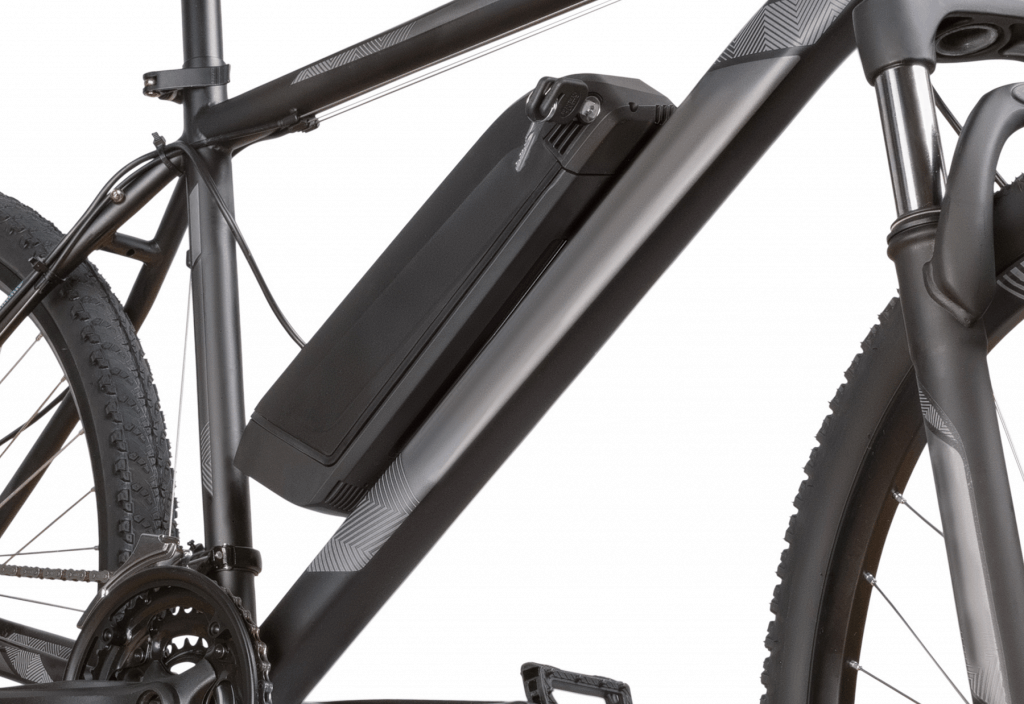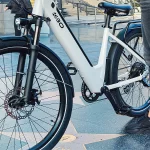Electric bikes aren’t usually cheap purchases. So if you’re thinking of buying one, you shouldn’t rush your choice. You should pay a considerable amount of attention, making sure you choose the right one for you. As part of doing this, you want to consider the choice of battery for your electric bike.
Alongside the motor, the battery is arguably the most important electric bike component to get right. Due to that it plays a crucial part in the bike’s performance.
The electric bike battery you choose, should meet your needs and preferences. The most important battery consideration is capacity. The bigger the capacity, the faster and further your electric bike will go. Bigger capacity, means higher cost and more weight though. Another consideration is whether your electric bike battery is internal or external. This is more a personal visual preference.
In this article, I will discuss the considerations you should make, when deciding on which battery for your electric bike. I will also discuss upgrading existing electric bike batteries. Advising how you can do this and giving important considerations with regard to this
Table of Contents
Lithium-ion Batteries
Before continuing, it’s worth mentioning lithium-ion batteries. These are increasingly becoming the standard battery type, for electric bikes these days. They are more efficient than the other battery types. This is due to the fact they can hold a higher capacity and therefore produce more power, for less weight. They also charge faster and last longer.
Battery Capacity
This is the most crucial aspect to consider, when choosing a battery for your electric bike. As mentioned above, battery capacity affects the bike’s speed and distance it will go. That is at least electrically assisted. Essentially, battery capacity impacts the bike’s performance.
Battery capacity, by the way, is not the only aspect that will affect the speed and distance your electric bike will go. These other aspects can include the ones mentioned below:
- Rider weight
- Bike weight
- Terrain and incline that’s ridden upon
- Motor power
- Motor type
- Carrying cargo
- Wind resistance
- Tire pressure
- Tire type
- Whether you’re using a throttle or pedal assist, or both, even
- How hard you’re pedaling whilst using pedal assist
- Choice of mode you’re riding in (whether riding in eco or turbo etc.)
- If you’re freewheeling down hills
With regard to the distance your electric bike will go on a single battery charge, using the electric assistance (this is referred to as range). The larger the capacity of your battery, the less of a concern the impact of the above factors will be.
For example, you may particularly need as much range as possible, if you regularly go on long bike rides. So a high capacity battery, can give you more confidence to take on bigger hills, on long rides. You could also be less sparing with using the higher mode settings (like turbo), during these long rides as well.
Essentially a high capacity battery can mean less range anxiety.

Referring back to where I mentioned battery capacity affects speed. A high capacity battery helps your electric bike go faster, because it has more power, to give more of a boost. This also means quicker acceleration, as well as better helping you to maintain speed. This extra boost, to help maintain speed, can be welcome for the below scenarios.
- If you’re a heavier rider.
- When you’re carrying cargo.
- You’re currently not at full fitness.
- For commuting and you want to get to work quickly, but not arrive in a sweat.
- When riding up steep hills.
- You may simply want to go faster for the pure fun of it, as is the case for many riders.
Aside from speed, a high capacity battery will help provide more power, to assist with these scenarios in general. This means these scenarios will use less of a percentage of the battery’s charge.
As mentioned before, though, the higher the capacity of a battery, the heavier it will be. So, if you won’t be using an electric bike for long journeys, you can opt for a low capacity battery. This will save you money and mean your electric bike will be lighter. You still want the battery capacity to be relative to the length of the journeys you’ll be making though.
How is the Capacity of an Electric Bike Battery Measured?
The capacity of electric bike batteries are measured by the following. Watt hours (wh), volts (v) and amp hours (ah). But what do all these mean?
Well, firstly, watt hours is the overall capacity of the battery. So generally the higher the amount of watt hours a battery has, the faster and further the electric bike will go.
To be specific about what watt hours actually are, they are defined as below.
Watt hours – The number of watts a battery can deliver, over an hour of constant use.
The amount of volts and amp hours a battery has, determines its capacity in watt hours. In fact, multiplying a battery’s voltage, by its number of amp hours, gives you the number of watt hours the battery has. This calculation is shown below.
Amp hours (ah) x Voltage (v) = Watt hours
This now brings me onto voltage and amp hours. Which are both defined as below.
Voltage – Refers to the speed/strength of electricity flowing through a circuit.
Amp Hours – Refers to how much electricity can be drawn over a period of time.

To be more specific about amp hours, it’s the number of hours a battery can draw 1 amp, from the number of volts the battery has. So, for example, for a 36v, 15 ah battery, if your electric bike is drawing 1 amp at 36v, then the battery will die after 15 hours. Amps, by the way, are a unit used for measuring electric current.
Anyway, you don’t need to know all this science behind these capacity measurements, when deciding on an electric bike battery. What is useful to know, though, is the below factors, with regard to voltage and amp hours.
- Voltage lends itself to speed
- Amp hours lends itself to range
So generally speaking, the higher the voltage, the faster the electric bike can go. Additionally, the higher the amp hours, the further the bike can go (will give a better range).
So you could have 2 separate electric bike batteries, both with the same number of watt hours. However, one could have a higher voltage than the other, but the other could have a higher number of amp hours. Here, you would expect the battery with the higher voltage, to cause an electric bike to go faster, than the other battery. Conversely, you would expect the other battery, that has the higher number of amp hours, to cause an electric bike to have a higher range.
Remember that speed and range is not an exact science though. This is due to the previously listed factors in this article, that can affect the speed and range of your electric bike. However, if you were to ride on 2 separate electric bikes, both like for like in specification except for their batteries, exactly the same way on the same route, then this is what you would expect.
Furthermore, with regard to the battery capacity not necessarily being an exact science. If you have, for instance, a 36v, 10ah battery and a 36v, 15ah battery, the battery which has 15ah would be faster. This is as well as having a further range compared to the 10ah battery. This is because the 15ah battery will have the higher wattage, making the battery more powerful in general.
What Capacities do Electric Bike Batteries Come In?
After advising how battery capacity is measured, you may be wondering what capacities electric bike batteries come in. So I will discuss this as below. This is to help give you a better idea of what to look for, when buying an electric bike.

Watt Hours
With regard to watt hours, the capacity can be around 150wh or 200wh for the extreme smaller capacity. At the extreme highest capacity, it can be around 900wh. This is as it currently stands in the market. You can, though, have electric bikes with dual battery systems. Here, the electric bike has 2 batteries attached at the same time, running in tandem. This can provide over 1000wh.
300wh to 500wh is the relative standard size of electric bike battery, which people generally have. I would say 500wh would be adequate for most people, but you can go upwards of this if your budget allows. At the end of the day, the more capacity you have, the further and faster you can go.
Bosch has provided an electric bike range calculator. This is to give you an idea of how much range you can expect from an electric bike, in different conditions.
Voltage
With the voltage, electric bike batteries are mostly 24v, 36v, 48v or even sometimes 52v. As you may gather, going up in increments of 12. Although you may sometimes find batteries with other voltages, such as 43v. You can even find some batteries that are as high as 60v, 72v or 96v. That sort of power would be excessive in most cases though. This is especially when there’s always a speed limit, for how fast electric bikes can go, using the electric assistance.
Although, a very high voltage can provide a beneficial boost if again, you’re a heavier rider, riding up steep hills, or you’re carrying heavy cargo. This can even be if you’re experiencing a combination of these.
Amp Hours
When it comes to amp hours, you’ll typically find this can vary from 5ah up to 28ah.
Applying the Electric Bike Battery Capacity to Your Needs
When deciding on what capacity battery for your electric bike, the determining factors are how much speed and range you want. One of these factors may be more important to you than the other, or maybe they are both equally important.
As mentioned before, the higher the capacity in watt hours, the more powerful the battery is overall. However, if speed is more important to you, then you should pay more attention to the voltage of the battery. Conversely, if range is most important for you, then you should pay more attention to the number of amp hours a battery has.
Below, I will give you more detailed advice, relating to choosing a battery that has the capacity you want. This is with speed and range in mind.
Range

Electric bike battery manufacturers will make all sorts of claims, about the range their batteries provide. However, the range you get out of any given electric bike battery, will always completely vary. This is due the varying factors listed previously in this article, that affect the range. So I would take range claims given by the manufacturers, with a pinch of salt.
As a general guide though, I’d say below is the average you can typically expect from a 500wh battery.
- 20 miles/32 km, if you’re using throttle only
- 35 miles/56 km, if you’re using pedal assist only
Therefore, expect less range from a 500wh battery, for the following scenarios.
- If you’re a heavier rider
- Riding on the highest pedal assist setting (turbo)
- When riding along a particularly hilly route
- If you’re carrying cargo
Likewise, expect more range from a 500wh battery, for the below scenarios.
- When riding on an especially flat route
- If you’re riding at a leisurely pace
- You’re using the pedal assist particularly sparingly
You could spend a lot of time assessing how much range a battery may give you. At the end of the day though, you can simply buy an electric bike with the highest capacity battery you can afford.
By the way, using a throttle only, uses up more battery power than using pedal assist only. This is because using the throttle only, means the electric motor is doing all the work. That’s why the expected battery range above, is less for throttle only, compared to using pedal assist only.
Calculating Battery Range

To give you a better idea of any given electric bike battery’s range, there is a calculation you can do.
Again, bearing in mind that determining battery range is never an exact science. Due to all the different events that can happen during a bike ride. This calculation is more to act as a guide, to give you an approximate/expected range. Nevertheless, this calculation will give you a much better idea of what range to expect from an electric bike battery, compared to going by the range given by the manufacturer. Which, again, you should take with a pinch of salt.
The first step of the calculation is knowing (or at least having an idea of) the average watt hours per mile that you’re riding at. Below are the typical watt hours per mile, for both using throttle only and pedal assist only.
Throttle only – 25 watt hours per mile
Pedal Assist only – 15 watt hours per mile
This is though, if using mid, to above mid level pedal assist settings. Say 3 to 4, if there’s 5 settings. Also, this is if you’re riding in the following riding conditions, which are fairly representative of most typical rides.
- The rider is of average weight (approximately 70 kilos/150lbs).
- Street riding (with maybe some light gravel/dirt here and there).
- Averaging at 20mph.
- Whilst riding on flat to relatively flat ground, with some light hills here and there.
You can now use either of the above mentioned watt hours per mile (depending on which one is most applicable), for the below calculation.
Battery range = watt hours of battery ÷ watt hours per mile
Below are a couple of examples of this calculation, using a 500 watt hour battery.
Throttle use only – 500wh battery ÷ (divided by) 25 watt hours per mile = 20 miles
Pedal assist only – 500wh battery ÷ (divided by) 15 watt hours per mile = 33.3 miles
So using the watt hours per mile mentioned before as a starting block, you can modify this to better match your circumstances. This is assuming they are different to those mentioned above.
For example, if your weight is around 250lbs, the watt hours per mile may increase by 3 to 5, from the figures given above. For example, up to 28 or 30 for throttle use only. Your battery consumption is not going to double, if your weight doubles by the way. The increase in weight is only going to slightly decrease the range. This is especially the case on flat ground.
Having said this though, if you’re riding on a hilly route as a heavier rider, you will use disproportionately more power/charge from your battery. Again, in general at least, being a heavier rider still only decreases the range a little.
The watt hour per mile is also likely to increase by 3 to 5, for the below circumstances. Again, compared to the above given figures for a typical bike ride.
- The bike itself is heavier than average
- You have fat tires
- You’re carrying light to moderate weight cargo
You may be a lighter than average person, or riding on level ground with no hills whatsoever. In which case, the watt hours per mile may decrease by 3 to 5, compared to a typical ride. For example, down to 12 or 10, if using pedal assist only. You may even be riding on the lowest setting throughout the whole ride (level 1/eco) with these conditions. Here, the watt hours per mile could be as low as 5.
It may take a bit of trial and error, to get a good idea of the watt hours per mile, for various cycling scenarios. But using the previously mentioned watt hours per mile for typical rides, is a very good starting point to use as a guide.
Calculating the Battery Size Needed for a Required Range
You can reverse the above talked about calculation, to get a range. This is to get an idea of how big a battery you’ll need, for the cycling journeys you intend to do. This reverse calculation is shown below.
Watt hours per mile x (multiplied by) number of miles required = total watt hours required (battery capacity required)
The below example, shows how you can use this calculation to determine the battery capacity you’ll need, if you’re using pedal assist only, to ride 20 miles in average conditions.
15 watt hours x (multiplied by) 20 miles = 350 watt hour battery
If you prefer to go by kilometers, then it’s helpful to know that 1 mile is equal to 1.609 kilometers. So you can apply the below pointers to the above calculations, if you prefer kilometers.
- If you’ve used the 1st calculation to get the expected battery range in miles. You can then multiply this range in miles by 1.609, to get the range in kilometers.
- For the 2nd calculation (1st calculation in reverse), if you have the distance in kilometers for a cycle journey you want to make. You can divide this by 1.609 to get the distance in miles, for this to then be used in the calculation.
If you’re using this calculation, to determine what size battery you need, for the journeys you’ll make. Which can be as part of choosing an electric bike to buy, by the way. It’s a good idea to opt for a battery that’s bigger than what you need (budget permitting). This is so that you have a bit of leeway, in case it’s ever needed.
Speed (General Boost)

As a reminder, you should pay attention to a battery’s voltage, if the below are a priority for you.
- The speed your electric bike can go.
- The general extra boost your electric bike provides.
A battery of 36v would generally be OK for the average rider (in terms of fitness and weight), if you’re not doing much hill climbing. This also goes, if you’re a relative cycling purist, who just likes a little extra help here and there. You would usually expect to see batteries up to 36v on lower powered electric bikes, with 250w to 350w motors.
You may be a heavier rider, or intending on carrying cargo, or anticipating going up many hills. In which case, a 48v, or even a 52v battery (if your budget can stretch that far), are likely beneficial options for you. These voltages will give you an extra boost. 48v batteries are the most common, for electric bikes with a motor of 500w upwards.
A 48v battery will help you accelerate quicker compared to a 36v battery. This can help you get out of dangers way quicker at junctions. Additionally, this can also help you get back up to top speed again sooner. This is especially beneficial if you’re doing a lot of stop-start riding. For example, if you’re getting stopped by traffic lights often whilst commuting.
Below shows how the 3 most common electric bike battery voltages are considered, in terms of the power they provide.
24 Volts – Low end Power
36 Volts – Medium Power
48 Volts – High end Power
As mentioned earlier in this article, you can get batteries with voltages above 48v, like 52v and 60v. In most situations though, this sort of power is likely to be under utilized. Particularly, when you take into account electric bike speed limits. But again, it’s there if needed. The increased voltage of these batteries will increase their watt hours (overall capacity). So this will also increase the range the bike will give. However, if 36v or 48v is going to give you the speed and power for your needs, then you may be better off opting for a battery, with as high an amount of amp hours, that your budget will permit. Rather than opting for a battery with a voltage above 48v. This is to allow you to get as much range as possible from your battery.
You may have to compromise between amp hours and voltage, if you have a limited budget.

A 52v battery will not give you a huge increase in speed compared to a 48v battery, whilst riding on the flat. There is more of a notable difference, though, between a 36v and a 48v battery. This YouTube clip demonstrates this. It shows someone riding an electric bike with a 350 watt motor, using the throttle only, on a flat surface. Firstly with a 36v battery and then a 48v battery.
The clip shows the electric bike gets up to 26.1 mph, with the 36v battery and up to 32.5 mph, with the 48v battery (6.4 mph difference). Remember though, the electric bike speed limit is 20mph/32kmph in most States in the US. It is 15.5mph/25kmph in the EU and UK. This backs up that a 52v battery is excessive, in terms of the speed it helps provide, for the following. If you’re only ever riding on flat/relatively flat conditions and you’re of average weight and not carrying any/much cargo. This is though, unless you’re in other parts of the world, which may have higher speed limits.
You can ride an electric bike faster than the speed limit for where you’re based, if you’re riding on private land. As long as you have permission from the land owner. If this is what you’re planning, you could buy an electric bike that goes as fast as you can afford. Remember to be careful though, too much speed can be dangerous. The speed restrictions that are on public highways, are there for a reason.
Remember though, factors other than the battery, can help your electric bike go faster. This can include having a lightweight bike like a road bike, using lighter tires and having a powerful motor.
Calculating the Speed Your Electric Bike Can Go
As long as you know the voltage of your battery, the rpm of the motor and the diameter of your bicycle wheels in inches. You can then use the below calculations, to establish the speed your electric bike can go, in either mph or km/h.
rpm of motor x diameter of bicycle wheel (in inches) x 0.003 = speed in mph
rpm of motor x diameter of bicycle wheel (in inches) x 0.0048 = speed in km/h.
So below are examples of this calculation, to establish the speed of an electric bike in both mph and km/h, if the wheels are 26 inches and the motor is 200 rpm.
200 rpm x 26” (26 inches) x 0.003 = 15.6mph
200 rpm x 26” (26 inches) x 0.0048 = 24.96 km/h
Upgrading Your Battery
It’s sometimes possible to upgrade your electric bike battery to a bigger capacity one, for more speed and range. However, this is not always simple to do and there’s certainly some considerations.
How electric bike batteries are attached to the bike is not standardized. This is throughout the market as a whole. So often, if you were to buy a new battery, it can only be a like for like replacement, from the manufacturer. This is handy at least, if you want a spare.
A solution though, if you wish to upgrade your battery, is to buy a triangle battery. You can attach these types of batteries to your electric bike, an alternative way. This YouTube video, “Easiest Way To Upgrade Your Ebike Battery”, shows how you can do this.
 Electric bike triangle battery
Electric bike triangle battery
Increasingly in the market, more electric bikes are starting to become available, where you can buy a higher capacity battery from the manufacturer, compared to the original battery that comes with the bike. It remains to be seen, but as time goes on, this could become more standard.
Upgrading Considerations
If you’re upgrading to a higher capacity battery, you need to be cautious. You need to make sure it is still a capacity, that your motor and controller can handle.
The increased amount of amp hours and voltage, should not exceed the specified amp hour and voltage limit of your controller. If you do not adhere to this, you will risk burning your controller out. You do, though, have the option to upgrade your controller. This can help you to accommodate any increased battery capacity, if needed.
Your motor is not as sensitive as the controller though. You can upgrade to a higher voltage battery without damaging the motor, as long as you don’t overdo it. This is apart from any possible increased wear and tear, due to the increased power. So as long as your controller can handle it, you could opt for the below battery upgrades.
24v battery to a 36v battery
36v battery to a 48v battery
48v battery to a 52v battery
So, if your electric bike comes with a 24v battery, it would not be advisable to upgrade it to a 52v one. It may be too much of a jump for the motor to handle. Remembering, as mentioned above, you still need to be careful if upgrading your battery.
There will be a bit of trial and error here, when upgrading to a higher voltage battery. You don’t want the motor getting too hot whilst riding. This will be an indicator that the motor is being overloaded and at risk of burning out.

You can minimize the risk of burning out your motor, whilst riding with an upgraded battery, of a higher voltage. This can be done by the following. The upgraded battery can have a lower number of amp hours, compared to the original battery. This acts as a counterbalance. So you can keep the watt hours of the battery at a suitable capacity for the motor, with this option. This is a suitable means, if you want to increase your electric bike’s speed, but you don’t mind any compromise on the range.
Do bear in mind, though, that factors like rider weight and incline, affect the load placed on the motor. This contributes towards the voltage your motor is dealing with, at any given point. Again, this all involves an amount of trial and error, to make sure your motor is not overloaded.
You could upgrade your motor to one with a higher rpm per volt, to accommodate a battery upgrade. This is an expensive option though. If you were to start upgrading your motor as well as your battery, then it’s starting to get to the point, where you may as well upgrade your whole electric bike altogether.
Alternatives to Upgrading Your Battery
You may deem that replacing your existing electric bike battery, for a higher capacity one, is too much of a risk. This is due to any potential burn out to your motor and controller, if you overdo it. So luckily, there are alternative, safer ways to increase the range of your electric bike. I will talk about a couple of these below. By the way though, there are other ways to increase your electric bike’s range. These are certain behaviors and habits you can adopt. I discuss these in my article “How Can I Increase My Electric Bike Battery Range”.
Adding Range Extenders
You can opt for an electric bike, where the existing battery has the facility to have a range extender added.
A range extender is a power bank that is added to your electric bike and charges your battery, when the electric assistance is not being used. This can include if you’ve stopped for a break, or if you’re freewheeling down a hill. These range extenders are usually mounted to where your drinks holder would go. So they are more likely to be compatible with your electric bike, if you have an internal or integrated battery.
You can alternate between having the range extender added to, or removed from your bike. This means you can toggle between these 2 options, depending on the length of your journey. So if you don’t need the range extender, when you’re only going for a short journey, you can remove it to save on weight. You can then add it back on again later, for a longer journey. This makes range extenders a practical option
These range extenders can give you a significant increase in range. Some options are able to give you an increase of up to 75%. This depends on how much you’re prepared to pay, though.
Do be careful by the way, if you’re thinking of purchasing a range extender. This is because they may void the warranty with some manufacturers, so always check this. However, this won’t be an issue if buying one of these for an electric bike, where the warranty has already expired.
Carrying a Spare Battery
Opting for a range extender may not be for you. For example, this could be if it would violate your electric bike warranty. If this is the case, you could buy a spare (like for like) battery. You can take this out with you in a backpack, or on a cargo rack. This is another way to get more range, when you’re out on those longer rides.
The battery weight and size, can be a key consideration here. This is because you want a battery that’s easy and comfortable, to carry in your backpack. That’s if you don’t have a cargo rack. You would also want a battery that’s easy and quick to replace, whilst you’re out on a ride.
A spare battery has the 2 below advantages compared to a range extender.
- Spare batteries are more cost effective. Range extenders cost approximately the same as a replacement, like for like battery. However, a fully charged replacement like for like battery, will give you a 100% increase in range. Whereas range extenders, provide to up to 75% increase in range.
- With a spare battery, you’re not relying on charging the original battery, anytime you’re not using the electric assistance. As mentioned before, this is how the range extender works.
You may prefer a range extender though, if you don’t have a cargo rack, but you still prefer having everything you need, all on your bike. Cycling with a backpack to carry a spare battery, may not be appealing to you.
Internal Versus External Battery
Whether an electric bike battery is an internal or external one, has no bearing on the battery’s performance. It’s down to a personal visual preference, as to which type you opt for. There are also integrated batteries as well. These are a relative variation of internal batte

Captain Colyer is an expert in sustainable transportation with a Master’s degree in Environmental Engineering. With over 9 years of experience, he is dedicated to advancing eco-friendly commuting solutions. His work focuses on the latest advancements in electric bike technology and promoting sustainable living practices. At ElectricBikePlanet.com, Captain Colyer shares his in-depth knowledge and practical insights to help readers make informed decisions about electric bikes. Join them on their electric journey for the best e-bike advice and recommendations, and connect on Facebook, Pinterest, and Instagram.







